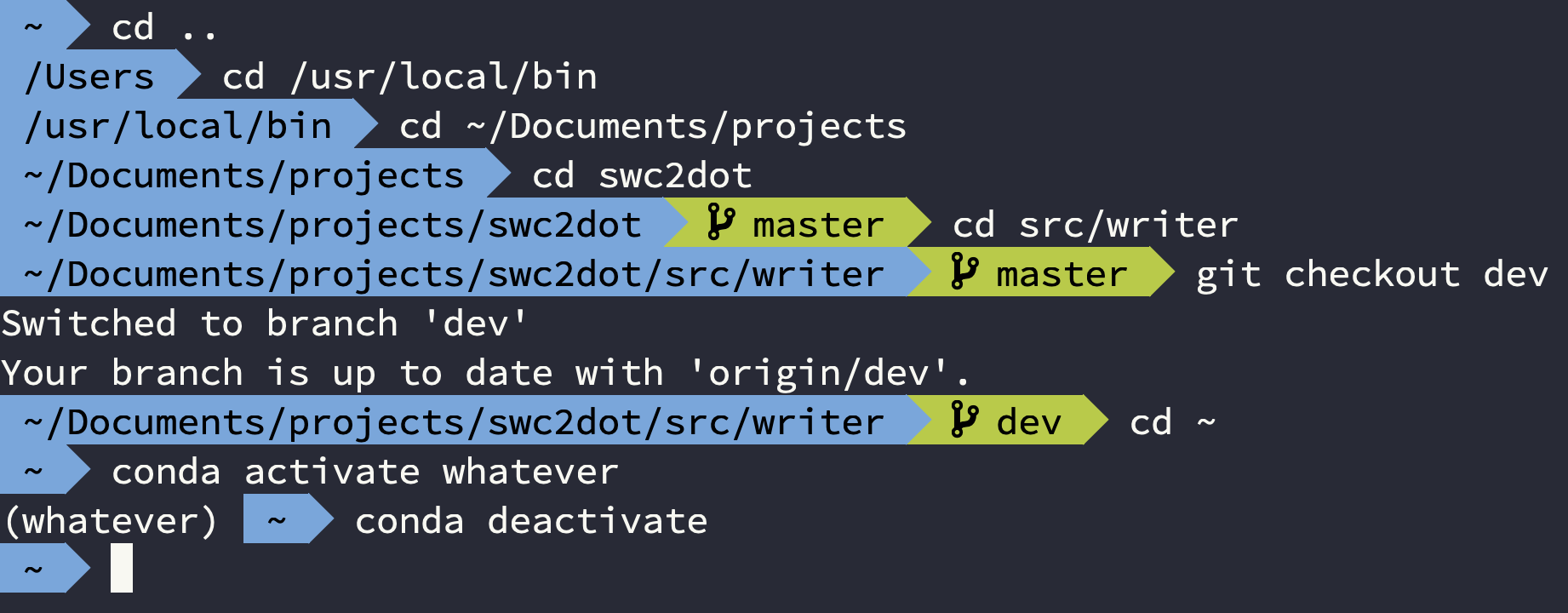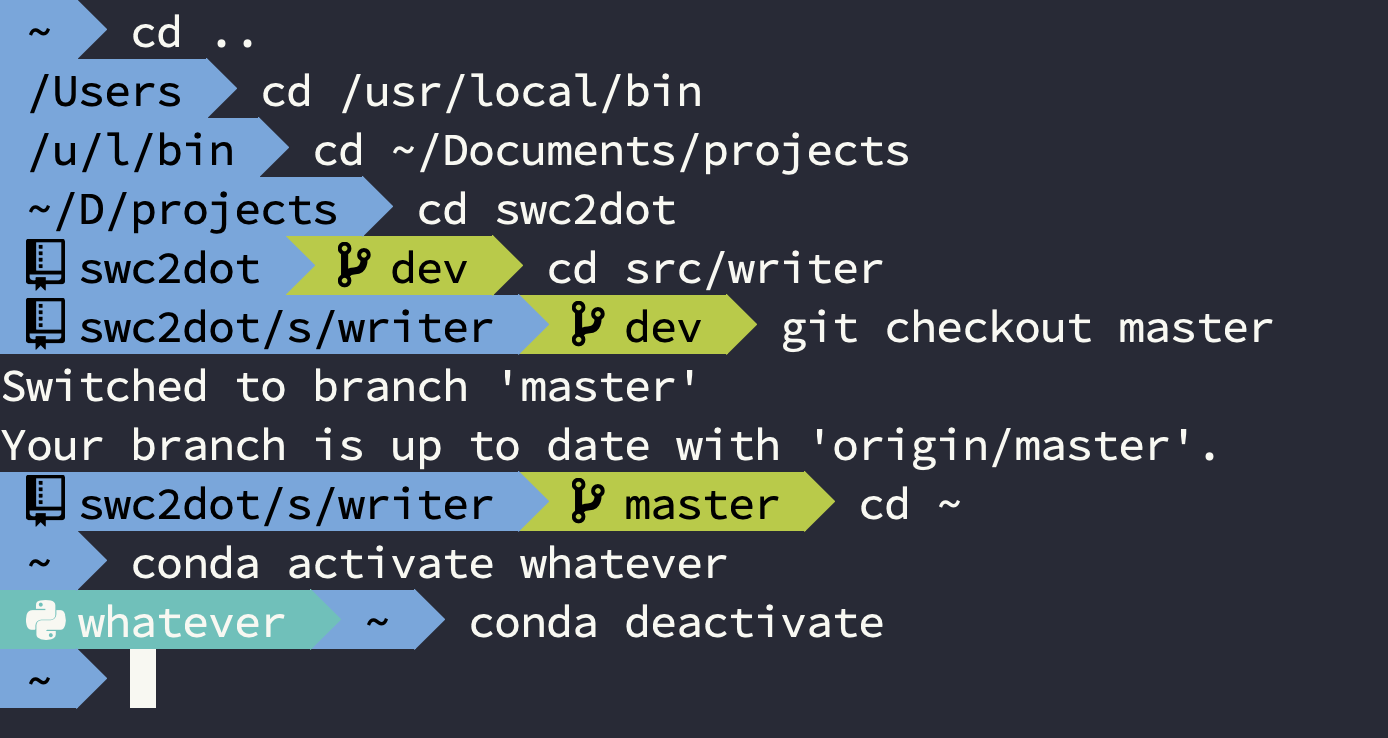A better zsh prompt for python development
I switched to zsh recently and there’s a lot to like. The agnoster theme from Oh My Zsh! provides a lot more useful information than I’m used to having in my bash prompt (the current git branch, and the exit status of the last command, for starters), and it just works out of the box.

Undeterred by agnoster’s excellent defaults, I spent some time tweaking the prompt and came up with something that works just a little bit better for python development. My version is Anaconda-aware, and displays a shorter path when inside a git repo.

Minor gripes with agnoster
Gripe #1: It isn’t Anaconda aware
I’m usually working on at least a couple of different python projects at any one time, each with its own Anaconda virtual environment. Agnoster can display the name of the virtual environment that you’re currently in as part of your prompt, but unfortunately it doesn’t detect Anaconda virtual environments out of the box. Even worse, Anaconda prepends the name of the current environment to the beginning of your prompt by default, spoiling Agnoster’s powerline aesthetic.
Solution
If you want something done right, you have to do it yourself. First, stop
Anaconda from modifying your prompt by adding the following line to your top
level .condarc.
changeps1: false
(If python isn’t literally the only thing you use in the terminal, you may also
want to stop Anaconda from activating the base environment automatically. This
can be configured by adding auto_activate_base: false.)
Next, we need to add the name of the active Anaconda environment to the prompt.
The prompt_virtualenv() shell function controls how the virtual environment
part of the agnoster prompt is displayed, so we just have to add a couple lines
to insert the name of the current Anaconda environment (if one is active). The
default prompt_virtualenv() looks like this.
prompt_virtualenv() {
if [[ -n $VIRTUAL_ENV ]]; then
color=cyan
prompt_segment $color $PRIMARY_FG
print -Pn " $(basename $VIRTUAL_ENV) "
fi
}
We can get the name of the current Anaconda environment from the CONDA_PREFIX
environment variable.
$ conda activate whatever
$ echo $CONDA_PREFIX
/opt/miniconda3/envs/whatever
Since this actually gives the absolute path to the Anaconda environment, we can
extract the name of the environent with basename $CONDA_PREFIX. Adding this
into prompt_virtualenv() (and applying a touch of refactoring), we get the
following.
prompt_virtualenv() {
# Get the name of the virtual environment if one is active
if [[ -n $VIRTUAL_ENV ]]; then
local env_label=" $(basename $VIRTUAL_ENV) "
fi
# Get the name of the Anaconda environment if one is active
if [[ -n $CONDA_PREFIX ]]; then
if [[ -n $env_label ]]; then
env_label+="+ $(basename $CONDA_PREFIX) "
else
local env_label=" $(basename $CONDA_PREFIX) "
fi
fi
# Draw prompt segment if a virtual/conda environment is active
if [[ -n $env_label ]]; then
color=cyan
prompt_segment $color $PRIMARY_FG
print -Pn $env_label
fi
}
The above gives a prompt that looks something like this (python icon not included).

Gripe #2: The prompt is too long
By default, agnoster shows the full path from / or HOME to your working
directory. I find this to be a bit overkill; if I really want to know the full
path, I’ll just use pwd. Most of the time, I only care about where I am
relative to the top of a git repo.
Solution
Override the promp_dir() shell function to display a shorter path. What
follows is a shell function in three acts:
- Get the path from root, home, or the top of the current git repo (whichever is shortest) to the working directory.
- Shorten directories above the current one to only one letter (for example,
path/to/dirbecomesp/t/dir). - Draw the prompt segment.
prompt_dir() {
# Get the path from home, root, or git repo to the working directory
if [ -d .git ]; then
# If the current directory is the top level of a git repo,
# just add the name of the repo to the prompt and exit.
prompt_segment blue $CURRENT_FG
print -Pn "$(basename $(pwd)))"
return 0
elif $(git rev-parse > /dev/null 2>&1); then
# If we're in a git repo, get the path from the top of the repo to the
# working directory.
local abs_path_=$(pwd)
local git_toplevel="$(git rev-parse --show-toplevel)"
local path_=${abs_path_#$git_toplevel}
else
# If we aren't in a git repo, get the path from either root or home to
# the working directory.
local abs_path_=$(pwd)
local path_=${abs_path_#$HOME}
if [[ $abs_path_ != $path_ ]]; then
local path_="~/$path_"
else
local from_root=1
fi
fi
# Shorten the path by truncating each directory (except the current one) to
# only one letter.
local path_as_array=(${(s:/:)path_}) # Split the path at forward slashes
local length_of_path=${#path_as_array[@]}
local shrunken_path=""
if [[ $length_of_path != 0 ]]; then
for i in {1..$length_of_path}; do
if [[ $i != 1 || $git_toplevel ]]; then
# Add a separating slash
shrunken_path+="/"
fi
# Truncate the dir name to the first letter, unless it is the
# current dir
if [[ $i != $length_of_path ]]; then
local elem="$path_as_array[$i]"
shrunken_path+="${elem[0,1]}"
else
local elem="$path_as_array[$i]"
shrunken_path+="$elem"
fi
done
fi
if [[ $from_root ]]; then
local shrunken_path="/"$shrunken_path
elif [[ $git_toplevel ]]; then
local shrunken_path="$(basename $git_toplevel)$shrunken_path"
fi
# Draw the prompt
prompt_segment blue $CURRENT_FG
print -Pn "$shrunken_path"
}
This will give you a prompt that looks something like the following (git repo icon not included).

Further reading
For the curious, you can find the full versions of my config files here.